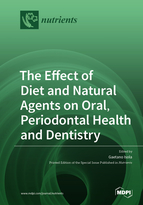The Effect of Diet and Natural Agents on Oral, Periodontal Health and Dentistry
A special issue of Nutrients (ISSN 2072-6643). This special issue belongs to the section "Phytochemicals and Human Health".
Deadline for manuscript submissions: closed (15 December 2019) | Viewed by 43836
Special Issue Editor
Interests: periodontitis; oral surgery; oral pathology; oral health-systemic health; bone biology
Special Issues, Collections and Topics in MDPI journals
Special Issue Information
Dear Colleagues,
Oral, periodontal diseases, chewing disorders, and many destructive inflammatory diseases of the supporting tissues of the teeth are caused by an imbalance between the host defense and environmental factors like bacteria, smoking, and poor nutrition. For these reasons, the focus should not only be on plaque control and removal of bacteria but also on improving host resistance through smoking abstention, stress reduction, and a healthy diet. The importance of micronutrients has been extensively reviewed, and it was concluded that prevention and treatment of periodontitis daily nutrition should include sufficient antioxidants, probiotics, natural agents, vitamin D, and calcium. Regarding antioxidants, vitamin C has attracted the attention of periodontal researchers. To date, there is limited available research investigating the effect of diet supplementation on the oral and periodontal condition.
Recently, a significant increase in medical literature on the effect of nutraceutical dietary aliments on general health has been noted.
The aim of this Special Issue is to provide a current and thoughtful perspective on the relationship of diet and natural agents on oral, periodontal diseases, and chewing disorder preventions which may reflect good systemic conditions and related quality of life.
I especially welcome interventional and observational studies aimed at improving the knowledge of the effects of nutraceuticals, natural products, vitamins, and effects of diet changes oral and periodontal diseases and how oral and periodontal treatment improve general health. Review studies including those that use conceptual frameworks for any of the aforementioned topics will also be welcomed.
Prof. Gaetano Isola
Guest Editor
Manuscript Submission Information
Manuscripts should be submitted online at www.mdpi.com by registering and logging in to this website. Once you are registered, click here to go to the submission form. Manuscripts can be submitted until the deadline. All submissions that pass pre-check are peer-reviewed. Accepted papers will be published continuously in the journal (as soon as accepted) and will be listed together on the special issue website. Research articles, review articles as well as short communications are invited. For planned papers, a title and short abstract (about 100 words) can be sent to the Editorial Office for announcement on this website.
Submitted manuscripts should not have been published previously, nor be under consideration for publication elsewhere (except conference proceedings papers). All manuscripts are thoroughly refereed through a single-blind peer-review process. A guide for authors and other relevant information for submission of manuscripts is available on the Instructions for Authors page. Nutrients is an international peer-reviewed open access semimonthly journal published by MDPI.
Please visit the Instructions for Authors page before submitting a manuscript. The Article Processing Charge (APC) for publication in this open access journal is 2900 CHF (Swiss Francs). Submitted papers should be well formatted and use good English. Authors may use MDPI's English editing service prior to publication or during author revisions.
Keywords
- Diet
- Nutrition
- Oral diseases
- Periodontal diseases
- Oral cancer
- Quality of life
- Chewing disorders
- Vitamins
- Probiotics
- Natural agents
- Baicalin
- Bromelin
- Transglutaminases
- Taste alterations
- Oral biofilm







